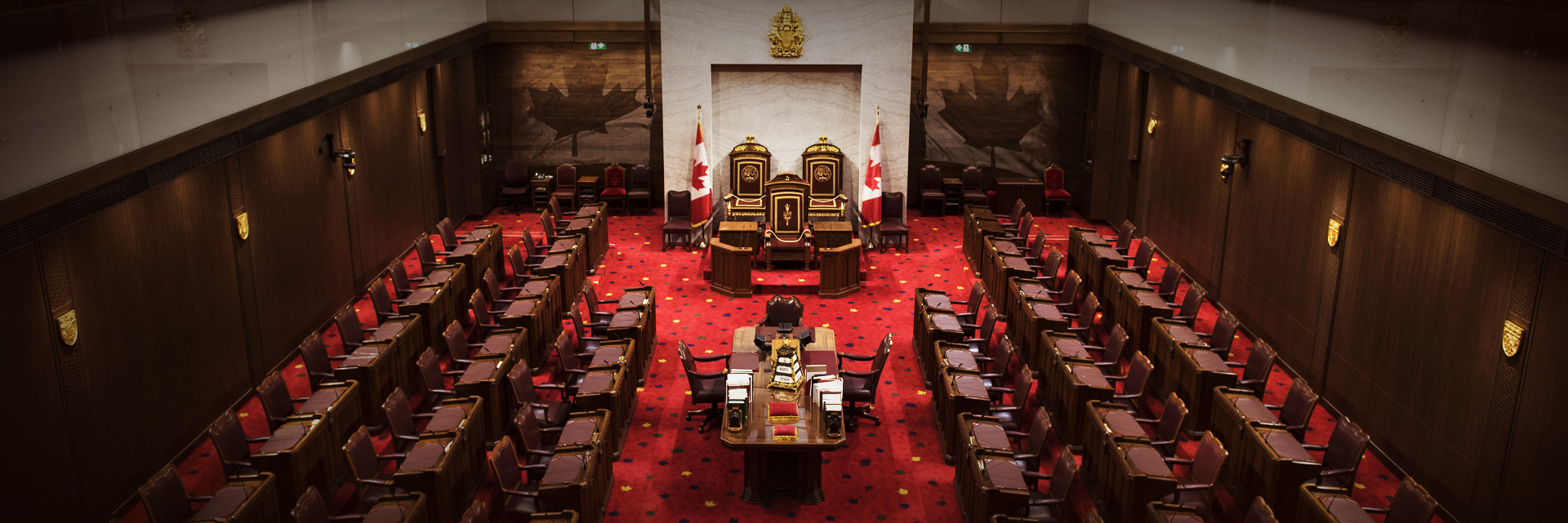
Budget 2023
Inquiry--Debate Continued
November 7, 2023
Colleagues, I rise today to draw your attention to certain measures in the 2023 federal budget related to climate change.
On page 69, Budget 2023 states the following:
Since 2015, the federal government has taken action to build Canada’s clean economy and create good middle class jobs. This includes: Putting in place a federal carbon pricing system, which puts money back in the pockets of Canadians and gives businesses the flexibility to decide how best to reduce their emissions . . . .
The centrepiece of these measures is imposing a price on those who produce greenhouse gas emissions, or GHGs. This policy was implemented in 2018 with the approval of the Senate.
The logic of carbon pricing is simple: Emissions that impose an environmental cost with pollution should have a price to encourage reduction at this time of climate crisis. Carbon pricing is considered by top economists to be the most efficient way to reduce carbon emissions. The yearly rising price is a powerful signal to consumers that fossil fuels will become more expensive and that decisions to adopt cleaner alternatives will result in substantial savings.
When alternative technologies exist or more efficient ones are readily available, the price on carbon provides a strong incentive to switch. The carbon price is not a punishment but an incentive to seek alternatives sooner than later and take action to reduce emissions to meet our targets. That is the reason why it is not, strictly speaking, a tax.
In their 2021 decision, the Supreme Court of Canada concluded at paragraph 219:
. . . The levies imposed by Parts 1 and 2 of the [Greenhouse Gas Pollution Pricing Act] cannot be characterized as taxes; rather, they are regulatory charges whose purpose is to advance the . . . regulatory purpose by altering behaviour. . . .
In June 2021, we passed Bill C-12, An Act respecting transparency and accountability in Canada’s efforts to achieve net-zero greenhouse gas emissions by the year 2050. The bill requires the government to set national GHG emissions reduction targets, and to establish a planning, assessment and reporting process for achieving net-zero emissions by 2050.
Unfortunately, reaching GHG reduction objectives is a major challenge. Earlier today, the Commissioner of the Environment and Sustainable Development, Jerry DeMarco, published a report finding that Canada’s 2030 Emissions Reduction Plan isn’t enough for the country to reach its emissions reduction target of 40% to 45% below 2005 levels by 2030.
As the chamber of detailed, non-partisan analysis, must we not reaffirm our commitment to meeting the set targets and to the carbon pricing policy recognized by a majority of economists in Canada and around the world as the most effective means of reducing greenhouse gas emissions?
Since the adoption of the carbon price policy, a lot of political rhetoric has emerged. Some claim that this policy has contributed significantly to inflation; others claim that this policy is responsible for the high price of food. But we, as independent senators, should not be moved by partisan lines, or by misleading arguments put forward by powerful lobbies. We should, rather, attempt to obtain all the relevant facts before reaching a conclusion.
One of these relevant facts is our inflation rate; it is currently at 3.8%, while it is at 3.7% in the U.S., 4.3% in the European Union, 4.9% in France and 6.7% in the U.K. Thus, it seems that we are doing better than many other developed countries.
On September 8, Tiff Macklem, the Governor of the Bank of Canada, indicated that 0.15% of the Canadian inflation rate can be attributed to the carbon price. To put it differently, in 2023, the carbon tax accounts for an extra $0.30 on a $200 grocery bill. If you want to go back to the time of its introduction four years ago, it now accounts for an extra $1.20 on a $200 grocery bill. Renowned University of Calgary economist Trevor Tombe confirms that the carbon tax is responsible for less than 1% of grocery price increases.
Another fact to consider is that the federal price on emissions is a backstop program. Respectful of our federal system of government, each province and territory can determine how to price carbon emissions to reach national targets. Currently, B.C. and Quebec are the two provinces that have put in place provincial programs to meet the reduction targets by measures adapted to their reality. To put it differently, the system was designed to provide provincial governments with flexibility on the details if they meet the scientific targets required to address the climate crisis.
As a result, under the existing provincial system, farmers in Quebec pay less carbon tax than those governed by the federal program. Meanwhile, other sectors of the Quebec economy may pay more.
Another feature of carbon pricing is the rebate system. Page 31 of the 2023 budget states that the federal price on pollution puts more money back in the pockets of 8 out of every 10 Canadians in the provinces where it applies. Incidentally, the Parliamentary Budget Officer, or PBO, agrees with that conclusion.
For the current fiscal year — 2023-24 — the Department of Finance estimates on page 207 of the budget that the proceeds from the pollution pricing framework will amount to $10.1 billion. For the same period, it estimates on page 212 that the proceeds returned will amount to $11.2 billion — which is $1.1 billion more. Quite clearly, the proceeds from the pollution pricing framework are not used to finance government operations, military procurement or social programs, but returned to Canadians.
According to the PBO, the costs of heating and curing fuels to farmers, including the carbon price, represent, on average in Canada, 0.8% of their overall expenses — estimated by Statistics Canada at over $77 billion. That percentage is 0.5% in Alberta, 0.4% in Manitoba and 0.3% in Saskatchewan.
There are, of course, some variations between the categories of farms. Without surprise, the largest share of energy costs compared to overall expenses is for greenhouses, which range between 4% and 5%. For that reason, greenhouses with glass roofs receive an 80% exemption from the carbon tax in order to impose on them a carbon price comparable to other farming enterprises in Canada. For oilseed and grain farms, heating and curing fuels represent 0.4% of their expenses, and for animal production farms, the percentage is 0.7%. Finally, under the current federal system, all farmers are also exempt from the diesel and gasoline fuel charge — used on farms for operating combines, tractors, trucks and some other machines.
Incidentally, the carbon price paid by farmers in the eight provinces and the territories in 2023-24 is estimated by the PBO at $13 million in connection with propane, and $63 million in connection with natural gas — for a grand total of $76 million. Also worth noting, 58% of this total will be paid by farmers in Ontario, 22% by those in Alberta, close to 16% by those in Saskatchewan and close to 4% by those in Manitoba. Those in the Atlantic provinces will pay about 1% of the total.
It is also worth noting that despite the April 1 increase of $15 per tonne on the carbon price — to bring it to $65 in 2023-24 — farmers using natural gas have paid, on average, less for it this year because the commodity price is down compared to last year.
The other thing we need to think about is the passage of Bill C-8, An Act to implement certain provisions of the economic and fiscal update tabled in Parliament on December 14, 2021 and other measures. My colleague, Senator Clément Gignac, sponsored this bill in the Senate. On June 10, 2022, at second reading, he talked about four amendments that Bill C-8 would make to the Income Tax Act. He described the fourth amendment as follows, and I quote:
Fourth, recognizing that a large number of farmers use natural gas and propane as part of their operations, Bill C-8 proposes a refundable tax credit to return fuel charge proceeds to farming businesses in provinces in which the federal fuel levy applies . . . .
The required steps to implement the refundable tax credit to farmers are now in place. Its operation can be summarized as follows: In each province, a pot is created where the carbon price paid by farmers is put. This amount is shared between the farmers of this province as a tax credit. The proportion allocated to each farmer is based on a percentage equal to his or her total expenses divided by the total expenses of all the farmers of the province.
The recent report from the Agriculture Committee regarding Bill C-234 contains a series of interesting observations adopted unanimously. One of them recommends that the Department of Finance work with the Canada Revenue Agency to target the refund more precisely and effectively to farms that rely on natural gas and propane. The committee also noted that if Bill C-234 is adopted, an adjustment to the credit system provided in the Income Tax Act will be necessary to avoid double compensation. Other observations deal with alternative technologies, additional support for agricultural clean technology and the fact that climate change is a major and worsening threat to the stability of Canada’s agricultural sector.
In closing, the climate crisis is causing death and suffering in Canada and around the world, as stated many times in this independent chamber. We have all breathed the smoke. Emissions continue to rise. We know what lies ahead for young people and future generations — unless we take urgent action. That is why our group, Senators for Climate Solutions, has urged us to do more. Let’s seize every opportunity to act.
Colleagues, what is the price of the air we breathe? What is the price of our grandchildren playing outside? What is the price of this miraculous earth? Let us reaffirm our support for a price on carbon and a greener economy.
To conclude, the Agriculture and Forestry Committee report should be part of the context as we proceed to a fulsome and thorough debate that will enable a fair discussion of all amendments and points of view throughout the chamber, to quote Senator Duncan.
Thank you. Meegwetch.
Would Senator Dalphond take a question?
Gladly.
Senator, the carbon tax appears to be practically sacred within Justin Trudeau’s government. However, when you look at the numbers with respect to reducing greenhouse gas emissions, British Columbia, the province with the highest carbon tax, increased its emissions by 4% from 2008 to 2019. Meanwhile, Nova Scotia, the province with the lowest carbon tax, reduced its greenhouse gas emissions by 36% over the same period.
Can you explain the logic in that?
Thank you, Senator Boisvenu.
Honourable senators, we would have to also compare the growth rates of Nova Scotia and British Columbia in terms of population and economic output, for example. We must note that there are many possible explanations for the increase in greenhouse gas emissions, because the more factories there are, the more carbon emissions are produced.
Senator Boisvenu, you’re absolutely right in saying that the fight against climate change requires determination. We can’t look at the numbers in the abstract. We need to tackle the problem head-on, specifically by cutting greenhouse gas emissions. That’s what the carbon tax does, and it’s designed to change behaviours. Economists, including Nobel Prize winners, have said so. Everyone agrees that this is the best policy.
Thank you.
Would Senator Dalphond take another question?
Senator, I’m sorry, but the time for debate has expired.

